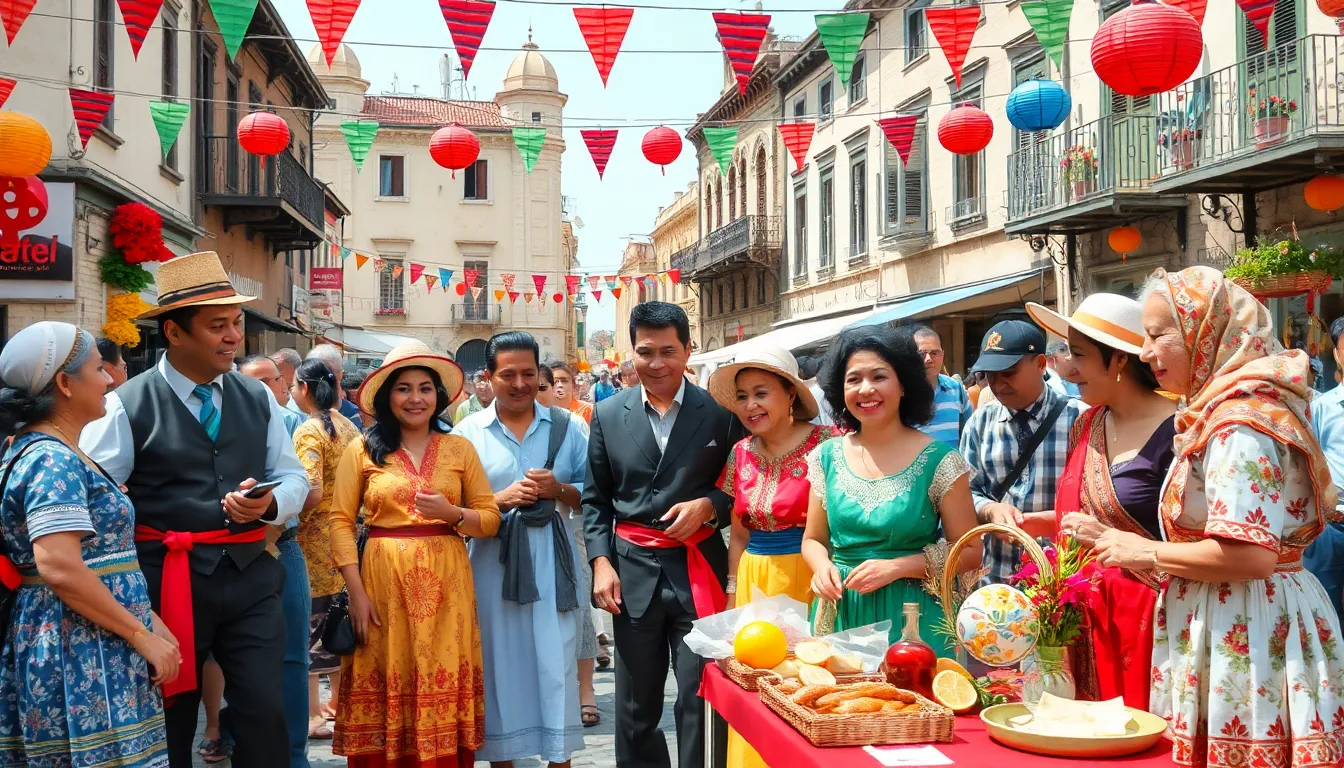Table of Contents
ToggleHeritage isn’t just a dusty old book on a shelf; it’s the vibrant tapestry of stories, traditions, and quirks that shape who we are. From grandma’s secret recipe to the odd family heirloom that no one quite understands, heritage gives life to our identities. It’s like a time machine that whisks us back to the good ol’ days, minus the awkward hairstyles.
Understanding Heritage
Heritage encompasses cultural, historical, and natural elements that shape communities and individuals. Traditions passed down through generations illustrate the values and beliefs of a group. Influences from diverse cultures expand the richness of heritage, creating a tapestry of various practices, languages, and art forms.
Artifacts, including ancient tools, traditional clothing, and historical documents, provide tangible connections to the past. These items reflect the lifestyle and adaptations of ancestors, offering insight into their daily lives. Furthermore, oral histories and storytelling maintain the continuity of cultural narratives, allowing families and communities to share experiences and lessons.
Communities often celebrate their heritage through festivals and events. These gatherings foster a sense of belonging and unity, encouraging individuals to explore their roots. Family bonds strengthen as members share dishes, music, and rituals that hold special significance.
Recognition of heritage plays a critical role in preserving cultural identity. UNESCO lists numerous sites and practices as world heritage due to their outstanding universal value. Protecting these elements ensures that future generations can appreciate and learn from the past.
Involvement in local heritage initiatives promotes awareness and understanding. Schools and community organizations often host workshops and educational programs, increasing appreciation for local customs. Active participation in these efforts amplifies a sense of responsibility toward safeguarding cultural legacies.
Heritage continually evolves, adapting to contemporary societal changes while remaining rooted in tradition. Innovations can blend modern influences with age-old practices, demonstrating that heritage is a living entity. Expanding awareness of heritage fosters mutual respect and admiration among diverse groups.
Cultural Significance of Heritage

Heritage plays a vital role in shaping cultural identities, showcasing the core values and beliefs of communities.
Traditions and Customs
Traditions and customs serve as crucial links to the past. They encompass rituals, celebrations, and practices passed down through generations. Various festivals, like Diwali or Thanksgiving, illustrate how collective values unite individuals. Celebrating these occasions fosters community ties, reinforcing identity. Many families observe unique customs, such as specific food preparations that symbolize heritage. These culinary traditions evoke cherished memories and enhance belonging. Engaging in cultural practices allows individuals to honor their ancestors while adapting to modern influences. Customary arts, crafts, and music further enrich the fabric of heritage, keeping essential narratives alive.
Language and Identity
Language acts as a fundamental aspect of cultural identity. It facilitates communication and preserves unique expressions within communities. Dialects and regional languages reflect diverse heritage through their nuances. Individuals often find a strong connection to their history and ancestry through language. Learning and speaking a native tongue fosters pride and belonging. Language influences thought patterns and social interactions, shaping how people perceive their world. It carries the weight of stories, traditions, and collective experiences. Multilingualism enriches cultural heritage, blending influences from various linguistic traditions. Understanding these connections enhances respect and appreciation for diversity within society.
Impact of Heritage on Communities
Heritage profoundly influences communities, shaping identities and experiences. Recognizing its impact fosters understanding and pride.
Economic Benefits
Heritage tourism boosts local economies, drawing visitors to cultural sites and festivals. According to the National Trust for Historic Preservation, heritage tourism generates $192 billion annually in the U.S. Local businesses benefit from increased foot traffic, leading to job creation and economic growth. Investing in the preservation of historical sites enhances property values, attracting further investments and encouraging community development. Preservation initiatives often stimulate restoration projects, providing direct economic returns while establishing a sense of place that people cherish.
Social Cohesion
Cultural heritage fosters social cohesion within communities. Shared traditions and practices create bonds among residents, reinforcing a sense of belonging. Events such as cultural festivals celebrate local heritage, nurturing community spirit and participation. Engaging in heritage activities encourages diverse groups to connect over common values and narratives. Research indicates communities with strong heritage connections often experience lower crime rates and enhanced civic engagement. By prioritizing heritage, communities cultivate inclusivity and mutual respect, further enriching their social fabric.
Challenges Faced in Heritage Preservation
Heritage preservation encounters various significant challenges that impact cultural identity and historical integrity.
Urbanization and Development
Urbanization poses a critical threat to heritage sites. Cities expand rapidly, often prioritizing new developments over historical preservation. Construction projects can lead to the destruction of cultural landmarks, erasing centuries of history. Local communities may find their traditions compromised as original structures give way to modern architecture. Preservationists advocate for integrating heritage considerations into urban planning. Collaborative efforts can create spaces that honor historical contexts while accommodating growth.
Climate Change Effects
Climate change presents another formidable challenge for heritage preservation. The increasing frequency of extreme weather events can damage historical structures. Rising sea levels threaten coastal sites, making some vulnerable to irreversible deterioration. Additionally, changing weather patterns may affect the materials used in traditional construction, leading to instability. Protective measures, such as improved flood defenses and climate-resilient materials, are essential for safeguarding heritage. Reacting to these challenges requires innovative approaches to conservation that adapt to the evolving environmental landscape.
Innovations in Heritage Conservation
Emerging technologies play a vital role in heritage conservation. Digital documentation, including 3D scanning and photogrammetry, captures intricate details of artifacts and historical sites, ensuring accurate records for future reference. Advanced materials now enhance restoration projects, providing longer-lasting solutions that preserve authenticity while mitigating environmental threats.
Collaboration among interdisciplinary teams continues to yield innovative outcomes. Architects, conservators, and scientists work together on projects, combining their expertise to develop adaptive reuse strategies that breathe new life into old structures. Universities and research institutions foster these partnerships, producing cutting-edge methodologies for conservation practices.
Community engagement transforms heritage conservation. Local residents often participate in restoration activities, strengthening connections to their history. Initiatives like workshops and educational programs raise awareness about the importance of preserving cultural heritage, fostering a sense of pride and ownership within communities.
Public-private partnerships emerge as effective models for funding conservation efforts. These collaborations combine resources from both sectors to support critical projects, expanding access to heritage sites. By sharing responsibilities and acknowledging shared interests, stakeholders ensure the sustainability of conservation initiatives.
Innovative software applications now facilitate access to heritage education. Virtual reality experiences offer immersive tours of historical sites, allowing users to explore locations that may be geographically distant. Digital storytelling platforms present narratives that connect individuals with their cultural backgrounds, enriching the understanding of heritage.
Research into environmentally sustainable practices enhances conservation efforts. Techniques that reduce energy consumption and incorporate eco-friendly materials become increasingly essential in addressing climate change challenges. By implementing these strategies, heritage conservation not only protects the past but aids in securing a sustainable future.
Heritage serves as a vital thread weaving together individual identities and community bonds. It’s a living entity that evolves while remaining anchored in tradition. The ongoing challenges of urbanization and climate change demand innovative solutions to preserve these cultural treasures. By embracing technology and fostering community engagement, societies can safeguard their heritage for future generations.
Recognizing the significance of heritage not only enhances cultural pride but also promotes social cohesion and economic growth. As communities celebrate their unique stories and traditions, they lay the groundwork for a more inclusive and respectful society. The journey of heritage preservation is not just about protecting the past; it’s about enriching the future.








